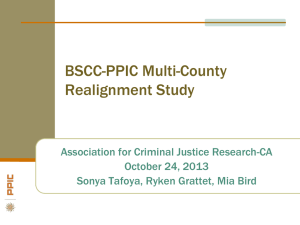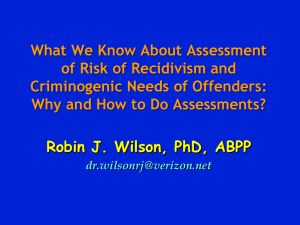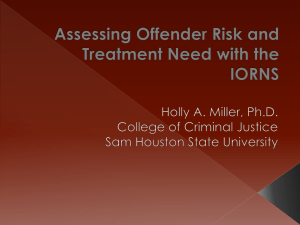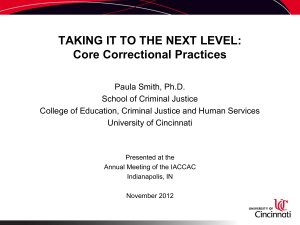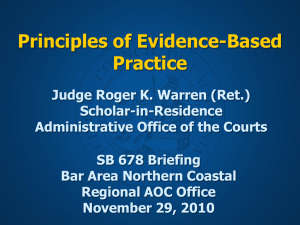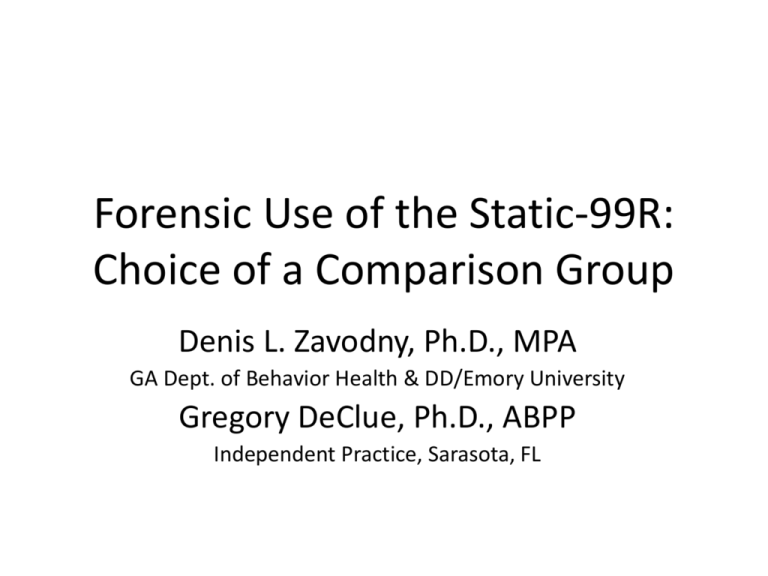
Forensic Use of the Static-99R:
Choice of a Comparison Group
Denis L. Zavodny, Ph.D., MPA
GA Dept. of Behavior Health & DD/Emory University
Gregory DeClue, Ph.D., ABPP
Independent Practice, Sarasota, FL
Sexual Violent Predator Considerations
1.
2.
3.
4.
5.
Past conviction of a sexual offense
Incarceration
Mental abnormality
Deficit in volitional capacity
Likelihood of future sexual violence
How likely is likely?
Static-99/99R Norms
• Revisions after discovery that more recent
samples had sexual recidivism rates lower
than rates observed in the developmental
sample
• July 2012 Workbook recommendation for
selection of comparison groups (Phenix,
Helmus, & Hanson).
Static-99R Comparison Groups
• Local Norms
• Routine “Full Population” of Convicted Sex
Offenders
• Non-routine/Preselected “Nonrepresentative” Groups
– Preselected Treatment Need
– Preselected High Risk
– Non-routine - Other
Which group to choose?
Local Norms
Local Norms
Generally, not available.
Routine Correctional – “Full
Population”
• Sex Offenders released from the Arizona Department of Corrections
(Bartish, Garby, Lewis, & Gray, 2003)
• Canadian federal (two or more years) sex offenders in Quebec 1995-2007
(Bigras, 2007)
• Contact sex offenders on probation in two boroughs of South East London
(Craissati, Bierer, & South)
• Sex offenders released from prison in Austria (Eher, Rettenberger,
Schilling, & Pfafflin, 2009)
• Sex offenders in North Dakota who were incarcerated or on
probation(Epperson, 2003)
• Canadian sex offenders on community supervision 2001-2005 (Hanson,
Harris, Scott, & Helmus, 2007)
• Sex offenders released from prison in Sweden (Långström, 2004)
Non-routine/Preselected on RiskRelevant Characteristics or Need for
Treatment – “Non-representative
Groups”
Selected as Needing Treatment
• New Zealand inmates convicted of child molestation who
completed prison-based sex offender treatment (Allan, Grace,
Rutherford, & Hudson, 2007)
• Canadian inmates treated at a maximum security psychiatric facility
(Brouillette-Alarie & Proulx, 2008)
• UK offenders (prison treatment in the 1990s, community treatment
in the early 1990s, and community treatment in the late 1990s;
Harkins & Beech, 2007)
• Washington state prison sex offender treatment program
(Johansen, 2007)
• Outpatient sex offender treatment at the University of Minnesota
(Swinburne Romine, Dwyer, Mathiowetz, & Thomas, 2008)
• British Columbia sex offender treatment in provincial prison
(Ternowski, 2004)
Pre-selected High Risk/Needs
• Referrals for pretrial forensic psychiatric evaluations in Denmark
(Bengtson, 2008)
• Canadian offenders flagged as potential Dangerous Offenders
(subject to indeterminate sentence; Bonta & Yessine, 2005)
• Canadian sex offenders with Warrant Expiry Date in 1995 (Haag,
2005)
• Offenders assessed or treated at the Massachusetts Treatment
Center between 1959 and 1984 (Knight & Thornton, 2007)
• Sex offenders treated at the Clearwater sex offender treatment
program in the federal forensic maximum-security facility in
Saskatchewan (Nicholaichuk, 2001)
• High-risk Canadian sex offenders detained after their Warrant
Expiry Date (Wilson, Cortoni, & Vermani, 2007; Wilson, Picheca, &
Prinzo, 2007)
Non-routine - Other
• Canadian federal offenders who received the
low or moderate intensity National Sexual
Offender Treatment Program (Cortoni &
Nunes, 2007)
• Sexual homicide offenders (Hill, Haberman,
Klusmann, Berner, & Briken, 2008)
• Sex offenders treated by the North Dakota
Department of Human Services (Staum, 2007).
Comparison Group Issues
• Considerable score variability within groups (Abbott, 2013)
• Limited detail about groups (Sreenviasan, Weinberger, Frances, &
Cusworth-Walker, 2010; Thorton, 2011)
– “The best method of determining which sample type is the most
appropriate match to an individual is not fully known” (Phenix et al.,
2012)
• Criterion contamination due to overlapping characteristics between
groups (Abbott, 2011)
• Insertion of subjective step into actuarial assessment providing
“legitimizing cover” (Prenkey, Janus, Barbaree, Schwartz, & Kaftka, 2006)
or a “veneer of ‘quantification’” (Sreenviasan et al., 2010) to clinical
judgment.
• Choice of comparison group often the key factor in the outcome of the
actuarial assessment.
Why not just select the High
Risk/Needs Comparison?
• High Risk/Needs group characterized as “referred for
services at forensic psychiatric facilities, such as offenders
referred as Mentally Disorder (sic) Sex Offenders, Sexually
Violent Predators….(Phenix, et al., 2012) but no SVP
candidates were included in the samples.
• Intentional or unintentional bias/allegiance effect (Murrie,
Boccaccini, Turner, Meeks, Woods, & Tussy, 2009; Murrie,
Boccaccini, Guarera, & Rufino, 2013)
• Selected High Needs/Risk group not drawn from general
population of state prison. Instead, specialized treatment
population between 1959 and 1984. However, there was a
49 percent decline in observed sexual abuse between 1990
and 2004 (Finkelhor & Jones, 2006).
Likely?
(Phenix, Helmus, & Hanson, 2012)
Routine/”Full Population”
• Score of 9: Estimated 5-year recidivism = 29.5 (22.8-37.2 95%
CI)
Preselected for Treatment Need
• Score of 8: Estimated 10-year recidivism = 39.6 (31.5-48.3
95% CI)
• Score of 9: Estimated 5-year recidivism = 38.1 (32.1-44.4 95%
CI)
High Risk/Need
• Score of 7: Estimated 10-year recidivism = 48.6 (41.4-55.9
95% CI)
• Score of 8: Estimated 5-year recidivism = 45.0 (39.3-50.8
95% CI)
• Score of 8: Estimated 10-year recidivism = 55.3 (46.8-63.6)
• Score of 9: Estimated 5-year recidivism = 52.4 (45.9-58.8
95% CI)
• Score of 9: Estimated 10-year recidivism = 61.9 (52.2-70.7
95% CI)
• Score of 10: Estimated 5-year recidivism = 59.7 (52.6-66.4
95% CI)
• Score of 10: Estimated 10-year recidivism = 68.0 (67.6-77.0
95% CI)
Non-routine
• Score of 8: Estimated 10-year recidivism = 46.3 (38.1-54.8
95% CI)
• Score of 9: Estimated 5-year recidivism = 44.3 (36.9-52.0 95%
CI)
• Score of 9: Estimated 10-year recidivism = 53.1 (43.4-62.6
96% CI)
• Score of 10: Estimated 5-year recidivism = 51.6 (43.6-59.6
95% CI)
• Score of 10: Estimated 10-year recidivism = 59.7 (48.7-69.8
(95% CI)
Search for Recent US Samples
• Sex Offender Civil Commitment Program
Network
• Contacting states with SVP civil commitment
program
• Researchers
• Public records request
Released from SO prison sentence
STATE
OBSERVED RECIDIVISM
FOLLOW-UP PERIOD
CT
24/746 (3.6%) Charged
20/746 (2.7%) Convicted
5 years
TX
2.0% (m. supervision)
5.5% (no m. supervision)
3.4% (all sex offenders)
5 years
WA
2.7%
5 years
MN
12% Arrested
10% Convicted
Average 8.4 years
MN
7.0%
12.9%
5 years
10 years
FL
5.2%
13.7%
5 years
10 years
NJ
3.5%
6.3%
5 years
10 years
SC
4.1%
7.0%
5 years
10 years
Screened by SVP/SDP program,
referred for evaluation, and
commitment recommended
STATE
OBSERVED RECIDIVISM
FOLLOW-UP PERIOD
TX
0.8% (m. supervision)
7.5% (no m. supervision)
2.25-7.5 years
(M =4.77, SD 1.52)
WA
34/135 (25.2%)
6 years
Found to meet SVP criteria, probable
cause found, or two evaluators opine
meet commitment criteria; released
without treatment
STATE
OBSERVED RECIDIVISM
FOLLOW-UP PERIODCA
CA
6/93 (6.5%)
4.7 years
SVP Program finds meets commitment
criteria; subsequently released
STATE
OBSERVED RECIDIVISM
FOLLOW-UP PERIOD
FL
6/155 (4%)
14/134 (10%)
30/241 (12%)
21/170 (12%)
0-3 years
3-5 years
5-10 years
10-14 years
Committed as SVP; judicially released
without completing treatment
STATE
OBSERVED RECIDIVISM
FOLLOW-UP PERIOD
FL
2/39 (5.1%)(any sexrelated charge)
2/39 (5.1%)(felony sexually
motivated offense)
0-10+ years
Committed as SVP; judicially released
after completing treatment
STATE
OBSERVED RECIDIVISM
FOLLOW-UP PERIOD
FL
5/61 (8.2%)(any sexrelated charge)
2/61 (3.3%)(felony sexually
motivated offense)
O-10+ years
Should “Selected High Risk/Needs
Comparison Group” be used because
the person has been referred for SVP
evaluation?
• No
• Although, with a recidivism rate of 25.2% over
six years, Washington sample was
comparable. However, Florida, Texas, and
California offenders recidivated at a rate closer
to the Full Population (Routine) Group.
Should comparison groups be selected
based on clinical considerations?
• Local norms recommended. When local norms are not available,
Full Population (Routine) Group is generally the best choice
• “Given that these norms are not often available, the routine
sample will usually reflect the most appropriate recidivism rates
as they are representative of typical sex offenders in the
correctional system” (Phenix et al., 2012).
• No empirical evidence showing that Preselected “Nonrepresentative” Groups results in increased predictive accuracy.
In fact, there is research that it decreases accuracy.
• Should always use the Full Population (Routine) Group. Could
use Preselected “Non-representative” Groups in addition to Full
Population (Routine) Group is there is clear evidence of
similarity between the individual’s sample and the research
sample
Implications
• Non-routine “non-representative” comparison groups
have higher recidivism than the Full Population
(“Routine”) group and provide evaluators an
opportunity to arrive at higher recidivism estimates,
sometimes two or three times higher than the Full
Population (“Routine”) group
• No empirical support for increased accuracy by the use
of non-routine “non-representative” comparison
groups
• Extant research consistently shows that clinical
adjustments from the standard actuarial rate decrease
accuracy of sexual recidivism risk assessments.
Future Directions
• Need research to test the accuracy of Preselected
“Non-representative” comparison groups vis-à-vis the
Full Population (Routine) comparison.
• Need research to determine if use of structured
instruments to guide comparison group selection
increases accuracy of risk determination
• Hanson and Phenix (2013) indicated that, based upon
subsequent data analysis, they anticipate abandoning
the “Selected as Needing Treatment” and “Nonroutine” comparisons groups and using recommending
the using only two comparison groups
DeClue, G., & Zavodny, D. L. (2013). Forensic
use of the Static-99R: Part 3. Choosing a
Comparison Group. Open Access Journal of
Forensic Psychology, 5, 151-182.
www.forensicpsychologyunbound.ws/OAJFP/Sex
_Offenders_files/DeClue%20and%20Zavodny
%202013.pdf
Contact Information
Denis Zavodny
atlpsychologist@gmail.com
Gregory DeClue
gregdeclue@mailmt.com

